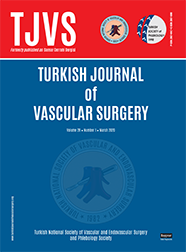
The Turkish Journal of Vascular Surgery
Yazarlar: Ekrem Aksu, Abdullah Sökmen, Gülizar Sökmen, Hakan Güneş, Nurhan Atilla, Bülent Güneri, Adem Doğaner, Mehmet Kirişci, Murat Kerkutluoğlu, Bayram Öztürk, Erdinç Eroğlu
Konular:-
Anahtar Kelimeler:Acute pulmonary embolism,Long-term mortality,Short-term mortality,Whole blood viscosity
Özet: Objectives: This study aims to evaluate the relationship of echocardiographic measurements, whole blood viscosity, and other hematological markers with short-term (0-30 days after the diagnosis) and long-term (31st day -12th month after the diagnosis) mortality in acute pulmonary embolism (APE). Patients and methods: This retrospective study included a total of 80 patients (35 males, 45 females; mean age 68.0±17.1 years; range, 22 to 92 years) with the definitive diagnosis of APE between January 2015 and December 2017. The patients were divided into three study groups as follows: short-term mortality group (n=20; 25.0%), long-term mortality group (n=15; 18.8%), and alive group (n=45; 56.2%) surviving beyond one year during follow-up. The demographic data, Pulmonary Embolism Severity Index, simplified Pulmonary Embolism Severity Index, complete blood count, N-terminal pro-brain natriuretic peptide (NT-proBNP), D-dimer, C-reactive protein, whole blood viscosity values, and echocardiographic measurements of the patients were recorded. Results: The increased levels of high shear rate-whole blood viscosity, low shear rate-whole blood viscosity, and the decreased levels of tricuspid annular plane systolic excursion were found to be associated with short-term mortality in APE. The red blood cell distribution width and NT-proBNP levels and pulmonary artery and right ventricular diameters were found to be associated with early and late mortality. Conclusion: Whole blood viscosity levels appear to estimate the patients susceptible to early mortality in APE, while late mortality seems to be predictable in the presence of increased red cell distribution width. Echocardiographic measurements seem to be applicable indicators of increased early and late mortality in APE.